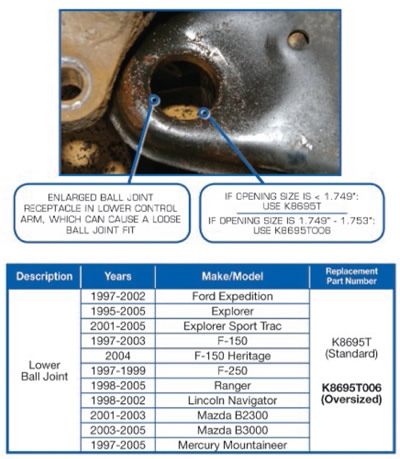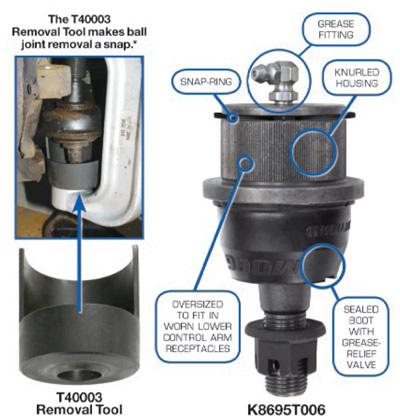The lower ball joint receptacle has been known to experience wear, especially when the ball joint has been replaced several times. If a traditional ball joint is installed in this situation, it will move and shift during operation, which can quickly wear out and damage the control arm, as well as causing unsafe handling issues.
Note: Lower ball joints in these applications are difficult to press out. When removing, an air hammer or chisel is not recommended as it can damage the control arm and the ball joint receptacle. Moog recommends the use of its T40003 Ball Joint Removal Tool.
Solution:
The MOOG K8695T006 (oversized) Ball Joint
The MOOG K8695T006 lower ball joint was designed for ease of installation and longer life.
• The ball joint is 0.006” oversized to fit in worn lower control arm receptacles.
• The snap-ring makes installation easy. The snap-ring in combination with the knurled housing keeps the ball joint securely in place. Use of an appropriate press tool, like the MOOG T40003, is recommended.
• The greaseable design ensures fresh lubrication reaches the bearing surfaces while flushing contaminants, while the all-metal gusher bearing design holds up to severe driving conditions.
Installation Notes:
– If opening size is < 1.749”, use K8695T.
– If opening size is 1.749”-1.753,” use K8695T006
The T40003 tool is designed specifically for removal of the ball joint on these vehicles. If the incorrect ball joint press receiver is used, you could mushroom the housing of the old ball joint and further enlarge the control arm hole, requiring replacement of the control arm.
Courtesy of: Moog Problem Solver BULLETIN: 29009









